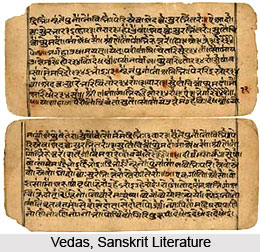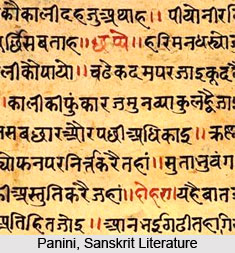Sanskrit literature bears its first initiations with the Vedas and continues with the Sanskrit epics of Iron Age. The golden age of Classical Sanskrit literature dates back to late Antiquity (approximately the 3rd to 8th centuries A.D). Sanskrit literature traces its roots back to the Vedic Age. Alexander's conquest of India was a significant episode in Sanskrit literature, which was fundamental to lay stress on Sanskrit drama. Despite the influence, Sanskrit plays uphold their individualism and subjects of the plays ranged from tragedy to light comedy. Many Sanskrit dramatists are also known to have based their works pivoting around the plot of Ramayana and Mahabharata. Sanskrit was the language spoken by a cultured minority.
 Sanskrit in Vedas and Upanishads
Sanskrit in Vedas and UpanishadsThe four Vedas in Sanskrit literature - Rig Veda, Yajur Veda, Sama Veda and Atharva Veda, each with a principal Samhita and a number of circum-Vedic genres, also includes Brahmanas, Aranyakas and Vedanga. The basic period of Vedic literary activity falls between the 9th to 7th centuries, when the various shakhas had amassed, collected and memorized their particular corpus. The older Upanishads (Brihadaranyaka, Chandogya, Jaiminiya Upanishad Brahmana, Katha, Maitrayaniya) also belong to the Vedic period, but the larger part of the Muktika canon is attributed to post-Vedic times.
Sanskrit Sutra Literature
Sutra literature under Sanskrit literature was the upcoming genre that had indeed witnessed much advancement in ancient Indian literary forms. Late Iron Age scholarship (ca. 500 to 100 B.C.E.) had built up knowledge into the cardinal Sutra treatises. The Sanskrit Sutra treatises had included the Vedanga and the religious or philosophical Brahma Sutras, Yoga Sutras and Nyaya Sutras. In the Vedanga categories of grammar and phonetics, no author perhaps has had impressed greater influence than Panini with his Ashtadhyayi (ca. 5th century B.C.). Panini's grammar indeed had successfully mended the grammar of Classical Sanskrit literature. Panini's grammar includes the elements like recursion, metarules, transformation and others.
 Sanskrit Literature in Hindu Epics
Sanskrit Literature in Hindu EpicsThe evolution of Sanskrit literature indeed had happened in a rhythmic and systematic manner with each period significantly following its predecessor. The Epic Age with their priceless Sanskrit epic poetry had appeared approximately between the 6th to 1st centuries B.C. It also witnessed the authoring and editing of the two great epics, the Mahabharata and the Ramayana.
The Mahabharata is considered as one of the largest poetic treatises in the world. While it is indelibly a masterpiece poetic epic in Sanskrit literature, it also comprises enormous tracts of Hindu mythology, philosophy and religious tracts. Ramayana in Sanskrit literature includes tales that form the basis for modern Hindu festivals and even comprises a description of that parallel marriage practice which is still observed in contemporary times by people of Hindu beliefs and thoughts.